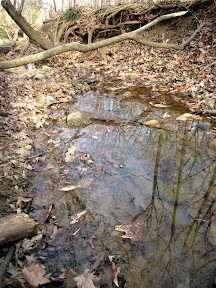Building understanding of the natural world begins in early childhood, in the sandbox and on fieldtrips
By Peggy Ashbrook
Posted on 2011-02-17
 In my early childhood experiences in a small creek below our house where neighborhood children waded and built dams, I learned many science and engineering concepts — the pushing force of moving water, its erosion of the sandbank, annual flooding depositing silt on the banks, algae growing on rocks in the backwaters, and the rounded edges of rocks in the creek making it hard to stack them. I would love to have such a creek on the playground, minus the polluted water and danger of drowning, of course.
In my early childhood experiences in a small creek below our house where neighborhood children waded and built dams, I learned many science and engineering concepts — the pushing force of moving water, its erosion of the sandbank, annual flooding depositing silt on the banks, algae growing on rocks in the backwaters, and the rounded edges of rocks in the creek making it hard to stack them. I would love to have such a creek on the playground, minus the polluted water and danger of drowning, of course.
A teacher writing on the NSTA Earth Science list tells about the misconceptions she has seen held by her 9th grade students: “…my students had to describe an island they had “discovered” and how the features of that island had come to be [and make a poster showing a model of their island]…, These students had performed fairly well on my more traditional assessments up to this point. When they presented their projects, I discovered that many, maybe even most of these honors and GT [Gifted and Talented] level students believed that islands float in the water; water flows out of the ocean and into rivers; and that rivers can flow up over mountains and even bisect islands. I am aware of misconceptions, but every time I come across a new one, I am newly surprised by it.”
I remember being similarly surprised by how differently a kindergartener and I viewed the landscape. We were on a bus on a bridge crossing over a major river, just a five minute drive from the school, and I said, “Look out the window!” My 5-year-old seatmate looked and said, “Wow, it’s a huge swimming pool!” Thinking that I would be helping him understand that we were crossing a river, I said, “Look out the other window.” He did and said, “There’s two of them!”
By learning what our students understand we can choose experiences that will help them build their knowledge. Digging riverbeds into the sandbox and building bridges to cross, making an island in the middle of a sandbox lake, or doing it in miniature indoors with small bowls and plasticine clay to build the landscape before pouring in a little water, are activities that young children enjoy. The sand will dry out and plasticine clay will dry off, to be used another day. By asking questions and having the children draw their created landscapes, teachers can help children build understanding which they can use in 9th grade Earth Science class.
Peggy
Disclaimer: The views expressed in this blog post are those of the author(s) and do not necessarily reflect the official position of the National Science Teaching Association (NSTA).


